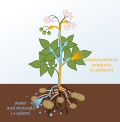Phloem
In vascular plants, phloem is the living tissue made up of small tubes which carry watery sap containing sugar and other organic nutrients to all parts of the plant where the nutrients are used for growth, or stored until needed. The sugar is made by photosynthesis. In trees, the phloem is the innermost layer of the bark, therefore the name, that comes from the Greek word φλοιος (phloios) for "bark".
Aphids (greenfly) and other insects feed on the phloem by inserting a fine tube into the plant, penetrating the tiny phloem cells deep within the plant. The high pressure in the phloem tubes forces the phloem sap into the insect. Most of the sugar passes right through the insect, so that nearby surfaces get sticky and often become black due to the growth of fungus.
Water, which is absorbed by the plant's roots, travels up the stem to the leaf through the xylem. This means that the xylem helps during photosynthesis by bringing water up the plant. It does the same job that blood vessels do in animals.
Phloem Media
Cross-section of a flax plant stem: Template:Ordered list*



